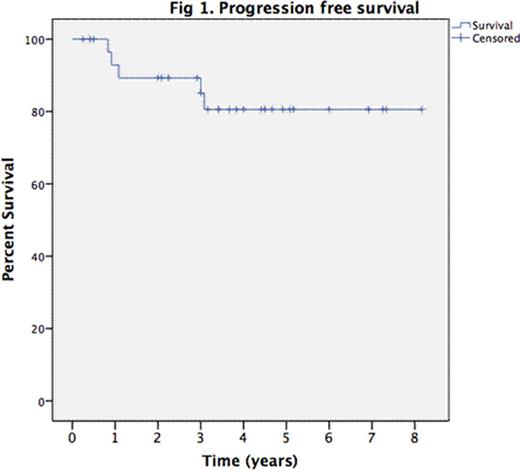Abstract
Introduction: Follicular lymphoma (FL) is the second most common non-Hodgkin lymphoma accounting for around 22% of them. Their natural history is characterized by multiple relapses and progressively shorter response durations after every new line of therapy for this is desirable to offer the best first-line approach to each patient. However, still now this aspect remains unclear. In the current guidelines several first line options are included: immunotherapy (Rituximab (R) x4 or Lenalidomide+/- R), immunochemotherapy (CHOP, RCVP, Bendamustine + R), radioimmunotherapy for elderly patients. Moving forward, the consolidation with radioimmunotherapy or extended dose immunotherapy (R every 8 weeks for 4 or 12 doses) still appears as an optional part of the therapy (NCCN V3.2016). Radioimmunotherapy with 90Yttrium-ibritumomab tiuxetan (90Y-IT) is available in our institution since 2006 and more than 100 patients have been treated with RIT since then. Here an institutional analysis focus in their use as consolidation is presented.
Aim: To analyze the experience with 90Y-IT as a consolidation therapy in patients in CR after first-line therapy.
Patients & methods: A retrospective analysis was performed including all the patients that have received RIT with 90Y-IT. Inclusion criteria were: patients 18 years or older with a grade 1-2a follicular lymphoma, RIT was received as a consolidation therapy in complete response (CR) after a first-line therapy. Demographic and follow-up data were included. International working group (IWG) criteria of response was used. Progression free survival (PFS) was calculated from the date of RIT to the date of a confirmed relapse according IWG criteria, overall survival (OS) was calculated from the FL diagnosis to the last contact.
Results: A total of 31 FL patients have received 90Y-IT been in CR after a first-line of therapy and were included for the study. Mean age at diagnosis was 61.2 (29-86) years with a female predominance (19, 61.3% vs. 12, 38.7%). 80.6% (26) with ECOG 0-1 and 19.4 ECOG 2. A third of them (10, 32.3%) were diagnosed with low tumor burden (stage I-II), 2 (9.7) of them presented extra nodal infiltration (subcutaneous and gut) and 12 (38.7%) showed bone marrow infiltration demonstrated by flow cytometer or biopsy. There were no patients with bulky disease. Stages: I: 7 (22.6%), II: 3 (9.7%), III: 9 (29.1%), IV: 12 (38.7%). As first-line therapy the patients received: Rx4: 11 (35.5%) cases, R-Cyclophosphamide vincristine prednisone (R-COPx6): 3 (9.7%) cases and 17 (54.8) R-cyclophosphamide doxorubicin, vincristine and prednisone (R-CHOP21x4-6). The median follow-up was 58.0 (10-107) months. During this time only 5 (16.1%) of patients have relapsed and need another therapy. None of the patients that have received R-CHOP+90Y-IT have relapsed; the relapsed patients received Rx4 (4) and R-COP (1). The median PFS after 90Y-IT has not reached, the mean was 83.3 (71.7-94.98) months, see Fig 1. Four (12.9%) patients have died, none of them were relapsed and the mortality was due to other causes. The median OS was not reached, the mean was 95.8 (85.6-106.1) months. As long-term events one 82 years old patient developed a colon cancer after 67 months of RIT, one 72 years old female a breast cancer after 17 months of RIT and one 71 years patients a MGUS after 24 months of RIT, none of them related with mortality events.
Conclusions: The use of immunotherapy with rituximab or combined schedules with immunochemotherapy (R-COP and R-CHOP) followed by consolidation with 90Y-IT remains as a valid option for follicular lymphoma patients. After ~5 years of follow-up: 63.6% (Rx4+RIT), 66.7% (R-COP+RIT) and 100% (R-CHOP+RIT) of patients continue with complete response and off of therapy.
No relevant conflicts of interest to declare.
Author notes
Asterisk with author names denotes non-ASH members.


This feature is available to Subscribers Only
Sign In or Create an Account Close Modal